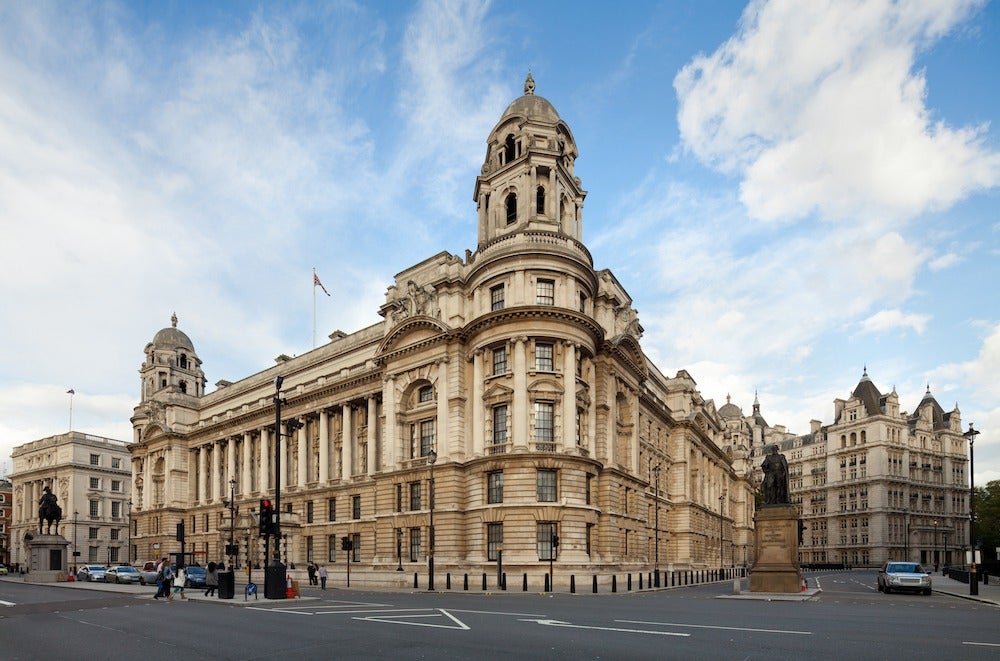
Buildings are not just square footage, but a historical artifact. Nick Foulkes discovers the history — and beauty — behind an apartment within the Old War Office used as headquarters for Winston Churchill during World War II.
There is something rather magical about visiting a building site that emerges from its chrysalis of cranes and scaffolding as an important building. It is always exciting to experience the first draft of what in time becomes a landmark, a little like knowing an actor or musician before they become famous.
The first memory I have of this was as a very young journalist in the late 1980s making my way down to the Docklands to inspect a large hole in the ground, a hole that would eventually become Canary Wharf. As there was no indication as to how anything would look or how tall it would be, the developer had taken the clever step of having a helicopter fly up to the spot that is now the top of the tower. More than 30 years later I can never see a picture of Canary Wharf without recalling that short helicopter ride subsequently made memorable by architecture.
Since then, I have been fortunate enough to visit a number of sites which will have become familiar to readers of Spear’s: George, before it was George, with the late Mark Birley; the bare walls of 25 Albemarle Street with his son Robin before it became Oswald’s; and more recently the princely floors above Claridge’s and the levels below, where Marc Newson and Jony Ive will open their new bar.
I felt this smug glow of having been years ahead of the game again recently, when I read that an apartment at the Old War Office had achieved £11,000 per square foot. Just pause and think about what it means. If you want to own a patch of a former government office block just about big enough to accommodate an iPad, you will have to pay what the average part-time worker in the UK makes in a year, or over a third of the average household disposable income. Given that the government guidelines for the minimum size of a studio is 37 square metres (a whisker underneath 400 square feet, and probably the size of a bathroom in that OWO apartment), the scale of the financial Everest one would have to climb becomes clear.
When it opened in 1906, the building was a metaphor for the empire that provided the political military collateral needed to enforce the Pax Britannica. Just as Sargent painted ‘swagger’ portraits of the gilded elite of the late 19th and early 20th centuries, so this was a ‘swagger’ building. As statistics attest, it was colossal: 1,100 offices, 21⁄2 miles of corridors, 19,000 feet of grilles in the floor to conceal the cables for telephones, 50 acres of plaster ceilings, 17 miles of plaster cornicing, and a kitchen capable of serving 1,000 lunches a day. Viewed from a passing omnibus, hansom cab or one of the new-fangled horseless carriages, the gleaming new citadel of Portland stone on Whitehall must have seemed capable of housing the entire government rather than just a single department.
In 2016 it was acquired by the Hinduja Group and an old friend of mine was tasked with publishing a history of this Whitehall grande dame. She turned to me to write it, and one grey London afternoon I turned up for the first of a number of hard-hat tours of the site. After 110 years it was again a fitting symbol of the political system that had begat it – following the disintegration of the empire it once policed, it was like the rusting hulk of an ancient ocean liner beached and left behind by the receding tides of history.
The once bustling corridors along which messenger boys used to scurry between departments were empty, echoing and coated with a layer of brick dust. Peering down into the interior light well revealed that a series of roofs had been stripped away from lower floors like the lid of a giant tin of sardines. Scaffolding and walkways made of roughhewn metal-ended planks of wood bridged spaces filled with piles of rubble and twisted iron. Balancing on bare joists, I navigated rooms from which floors were missing and roamed the roofline where I did my best to imagine a time when penthouses and hotel bars would rise here.
And then, amid the debris and deafening noise of a major construction site, a door would open, and I would be vouchsafed a gaze along an enfilade of interconnecting rooms overlooking Whitehall, or enter a towering room with which the chiefs of imperial staff would have been familiar, and through which history itself – in the varied forms of Lloyd George, Churchill and Profumo, interalia – once strode. It was here that MIs 5 and 6 were born and two world wars were run.
Having seen this, I can understand that one is buying not just a square foot of real estate, but a square foot of history. And, as yet, I know of no way to calculate the value, let alone the price, of that.
Image: Shutterstock






